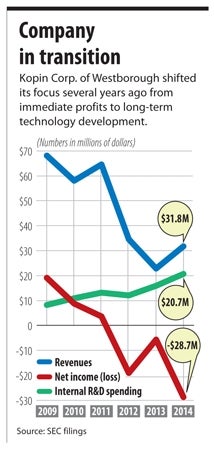How many times a day do you pull out your phone? One study, in 2013, found that the average smartphone user swipes to unlock 110 times a day. With smartwatches entering the market, it’s getting even easier for us to get the data we want in less than a second.
Westborough-based Kopin Corp. says it won’t end there. The 30-year-old technology company has made a major bet that the next stop in constant connectivity will be computers that live in your glasses.
“Watches are going to mature somewhat this year,” said Stuart Nixdorff, Kopin’s senior vice president of sales and marketing. “After that it’s a small step to glasses.”
The most-watched head-worn data device, Google Glass, got off to a somewhat rocky start, and Google discontinued production of the prototype product for consumers at the start of this year. But work on the product continues, and a number of other companies are entering the market, too.
For some of those other companies, including Samsung and Verizon, the emerging products are made possible by Kopin. The company has a long history of producing tiny displays, as well as other components, for equipment that includes military weapons and digital cameras. But in 2013 it shifted its focus toward the consumer wearables market.
Nixdorff said the company has no plans to produce products directly for consumers. Instead, he said, it’s more like Intel in the computer world or Qualcomm in smartphones. The idea is to invest heavily in developing new technologies, then work with the consumer-facing companies that make the finished products.
“We look at problems we see in the market that aren’t being solved,” Nixdorff said.
Right now, he said, the two key problems for head-mounted products are creating a seamless display — something that doesn’t make the wearer look like a cyborg — and changing the way the user communicates with the device. Instead of tapping a phone or a watch, the obvious way to communicate with a pair of glasses is by voice. So, Kopin has invested in improving voice recognition technology.
Kopin also creates reference designs that its customers can use as a basis for their own finished products and, in some cases, even builds a handful of prototypes for them to work from.
Matthew Robison, an analyst who follows Kopin for Wunderlich Securities, said the company “may have the broadest set of assets” among component makers for headsets. The big question, he said, is whether the devices will really catch on with consumers.
Already, there’s a strong market for rugged, pricey head-mounted data devices in the military. Interest is also growing in such fields as public safety and logistics. But those potential markets are never going to reach the volume the consumer market could potentially offer.
Future fashion statements
Robison said the industry is starting to address the geekiness issue, one of the big barriers to acceptance, as fashion franchises start to get involved in developing the look of the products.
But, he said, there’s also the question of whether consumers find value in sticking their smartphones on their faces. “The kinds of things you hear about as being consumer applications are translating road signs in foreign countries, things like that,” he said. “I’m not sure how far out of their way someone will go for something like that.”
Kopin is betting that the market will develop. It’s been in the red since 2012, while spending more on R&D. Nixdorff said you might say that, despite its long history, it has “switched into startup mode,” making bold investments into technological building blocks for a product that hasn’t yet developed a market.
“We do know that we have to invest now before the market is mature,” he said. Nixdorff admits it’s impossible to know when, or if, it will mature. But, looking at how quickly we’ve gone from pagers to flip phones to iPhones — with watches emerging as a mass market — he said smart glasses may be coming quite soon.
“I do see it as a highly likely evolutionary step,” he said.

